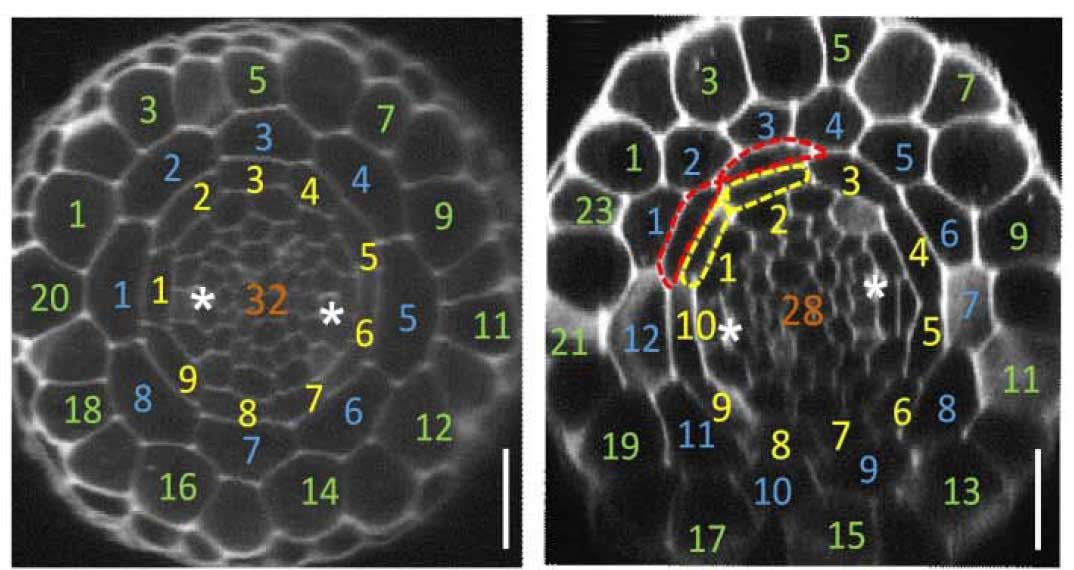博文
Plant Physiology:水杨酸影响拟南芥根分生组织模式建成
||
Salicylic acid affects root meristem patterning via auxin distribution in a concentration-dependent manner
First author: Taras Pasternak; Affiliations: Albert-Ludwigs-University Freiburg (弗莱堡大学): Freiburg, Germany
Corresponding author: Klaus Palme
The phytohormone salicylic acid (SA) is well known for its induction of pathogenesis-related (PR) proteins and systemic acquired resistance (SAR); SA also has specific effects on plant growth and development. Here we analyzed the effect of SA on Arabidopsis thaliana root development. We show that exogenous SA treatment at low (below 50 μM) and high (greater than 50 μM) concentrations affect root meristem development in two different PR1-independent ways. Low-concentration SA promoted adventitious roots and altered architecture of the root apical meristem, whereas high-concentration SA inhibited all growth processes in the root. All exposures to exogenous SA led to changes in auxin synthesis and transport. A wide range of SA treatment concentrations activated auxin synthesis, but the effect of SA on auxin transport was dose-dependent. Mathematical modelling of auxin synthesis and transport predicted auxin accumulation or depletion in the root tip following low- or high-concentration SA treatments, respectively. SA-induced auxin accumulation led to the formation of more layers of columella initials, an additional cortical cell layer (middle cortex) and extra files of epidermis, cortex and endodermis cells. Suppression of SHORT ROOT and activation of CYCLIN D6;1 mediated the changes in radial architecture of the root. We propose that low-concentration SA plays an important role in shaping root meristem structure and root system architecture.
植物激素水杨酸(salicylic acid, SA)能够诱导病原相关(pathogenesis-related, PR)蛋白和系统获得性抗性(systemic acquired resistance, SAR),同时SA对于植物的生长和发育有其特别的作用。本文中,作者分析了SA对于拟南芥根发育的作用。本文的试验显示外源低浓度(低于50 μM)和高浓度(高于50 μM)的SA处理通过两种不同的PR通路影响根分生组织的发育。低浓度的SA促进不定根和根尖分生组织的改变,而高浓度的SA则会抑制根中所有的生长过程。无论是低浓度还是高浓度的SA处理,二者均能影响生长素的合成和转运。各种浓度的SA处理均能激活生长素的合成,但SA对于生长素转运的影响依赖于剂量效应。生长素合成和转运的数学模型预测在低浓度的SA处理时,根尖中的生长素会积累;而在高浓度的SA处理时,根尖中的生长素会消除。SA诱导的生长素积累会导致多层柱细胞的形成,额外多一层中皮层,额外的表皮、中皮层和内皮层细胞。SHORT ROOT的抑制和CYCLIN D6;1的激活导致根辐射状结构的改变。作者认为低浓度的SA能够塑造根分生组织结构和根系统结构。
通讯:Klaus Palme(https://www.frias.uni-freiburg.de/de/das-institut/archiv-frias/school-of-lifenet/fellows/palme)
个人简介:弗赖堡大学,生物学;图宾根大学,化学;1981年,乌尔姆大学,博士;索尔克生物研究所、科隆大学遗传研究所,博士后。
研究方向:利用系统生物学研究植物激素信号、分子网络以及各种物质影响植物生长发育的机制。
doi: https://doi.org/10.1104/pp.19.00130
Journal: Plant Physiology
First Published: April 29, 2019
https://blog.sciencenet.cn/blog-3158122-1177408.html
上一篇:Cell:植物受伤后自愈过程中的干细胞通路重激活
下一篇:Nature Biotechnology:NRT1.1B作用于籼、粳稻大田条件下的根际微生物组成与氮利用效率差异
全部作者的其他最新博文
- • Plant Physiology:CsMADS3促进柑果中的叶绿素降解和类胡萝卜素合成(华中农业大学)
- • Molecular Plant:LBD11-ROS反馈调节作用于拟南芥的维管形成层增殖和次生生长(浦项科技大学)
- • Science Advances:根结线虫通过调控植物的CLE3-CLV1模块,促进侵染进程(日本熊本大学)
- • Nature Communications:油菜素内酯参与植物营养生长期转变的分子机制解析(浙江农林大学)
- • Current Biology:光合作用产生的蔗糖驱动侧根“生物钟”(德国弗莱堡大学)
- • PNAS:花同源异型基因在叶中被抑制、花中被激活的分子机制(南卡罗来纳大学)

